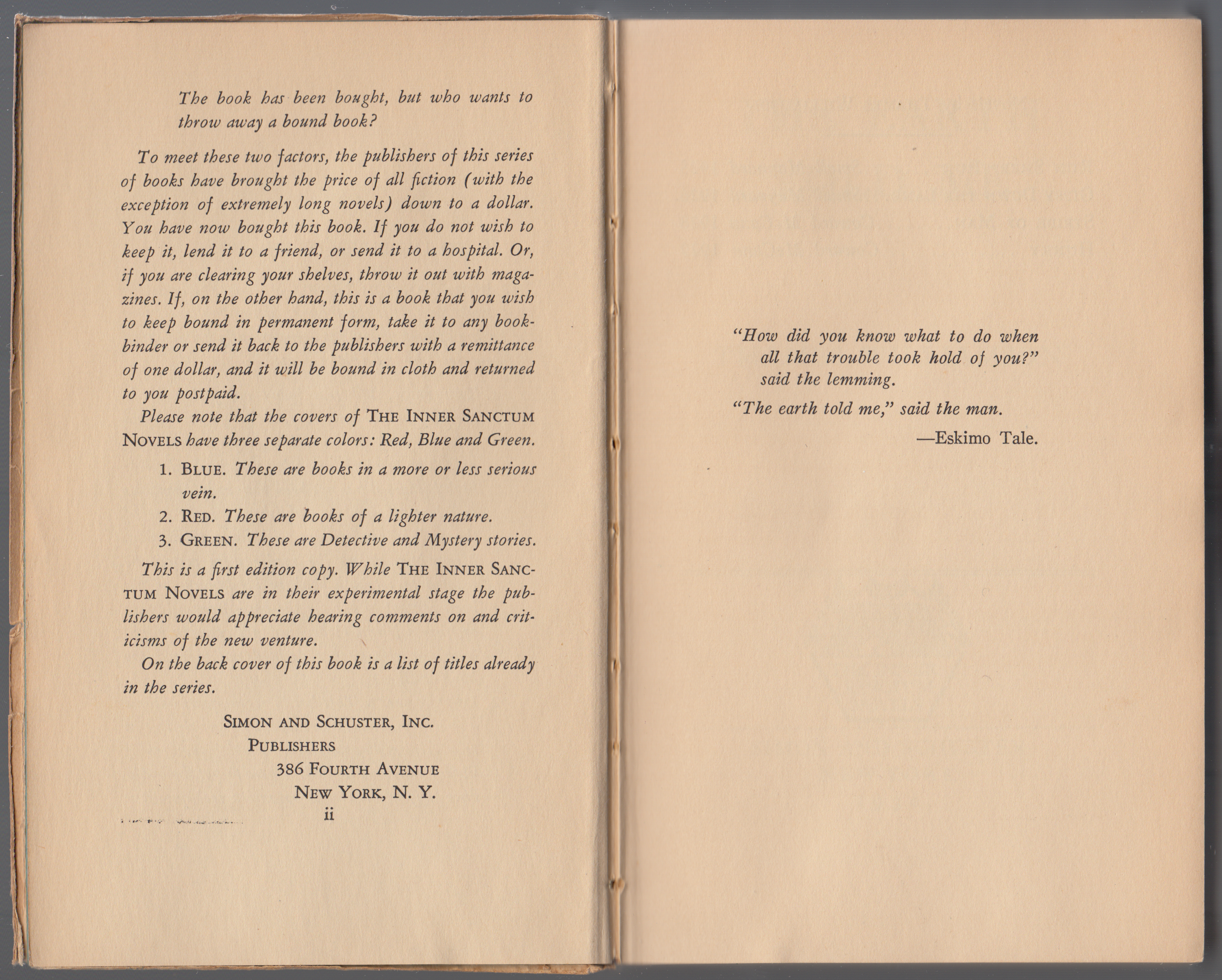Simon & Schuster (New York, US)
Series dates: 1930
Size: 4.75″ x 7.25″
Revised 6/6/2023
The Inner Sanctum Novels were a noble attempt at a series of low-cost ($1) paperbound new fiction launched at the start of the depression by publisher Simon & Schuster.
 The “Inner Sanctum” name had been used by Simon & Schuster before this series: for example, the first U.S. edition of Felix Salten’s Bambi (1928) was an “Inner Sanctum Edition.” The Inner Sanctum Mystery series commenced publication in 1936, which led to an Inner Sanctum Mysteries radio program in 1945. The Inner Sanctum name on mysteries was used until at least 1979.
The “Inner Sanctum” name had been used by Simon & Schuster before this series: for example, the first U.S. edition of Felix Salten’s Bambi (1928) was an “Inner Sanctum Edition.” The Inner Sanctum Mystery series commenced publication in 1936, which led to an Inner Sanctum Mysteries radio program in 1945. The Inner Sanctum name on mysteries was used until at least 1979.
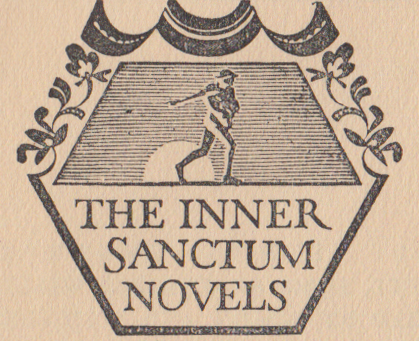 The Inter Sanctum Novels series appears in July of 1930, about 10 months after Albert & Charles Boni’s Paper Books and Bonibooks series (first issued in September 1929). The Paper Books series also promoted new fiction in paperbound books at a low price, but, in the case of Paper Books, the titles were part of a subscription book club.
The Inter Sanctum Novels series appears in July of 1930, about 10 months after Albert & Charles Boni’s Paper Books and Bonibooks series (first issued in September 1929). The Paper Books series also promoted new fiction in paperbound books at a low price, but, in the case of Paper Books, the titles were part of a subscription book club.
These two series reveal the challenges of publishing and selling new fiction early in the Depression. Buyers might not want to pay $2.50 or $3 for an unknown author (or for fiction titles in general, which may only be read once). Cheaper paper-bound books and book clubs might be solution to these problems. Alas, these experiments did not succeed.
The Paper Books were quickly reimagined as the Bonibooks series (the club approach dropped) and their format evolved towards hardcover books (to start, paperbound books in slipcases, then in actual hardcovers) and in this form survived into 1943. The Inner Sanctum Novels ended after the initial eight titles were issued.
Attempts to produce lower-cost hardcover fiction also did not work: Coward McCann issued four novels in its Premier Fiction series in 1930 at $1.50 each. No more titles appeared.
In general, these failures may be as much about the Depression as they were about book format and content. Reprint series (such as the Modern Library and Everyman’s Library) continued to do well, and Penguin Books (mostly but not all reprints) would, in 1935, get book buyers into paperbacks. But these were reprint series and avoided the issue of new fiction by lesser-known authors.
The Inner Sanctum Novels were advertised in the Saturday Review of Literature on October 5, 1929 (left) and August 9, 1930 (right). Mentions of the series abounds in literary magazines and other sources, suggesting the series was well advertised and received. (right mouse click to enlarge).
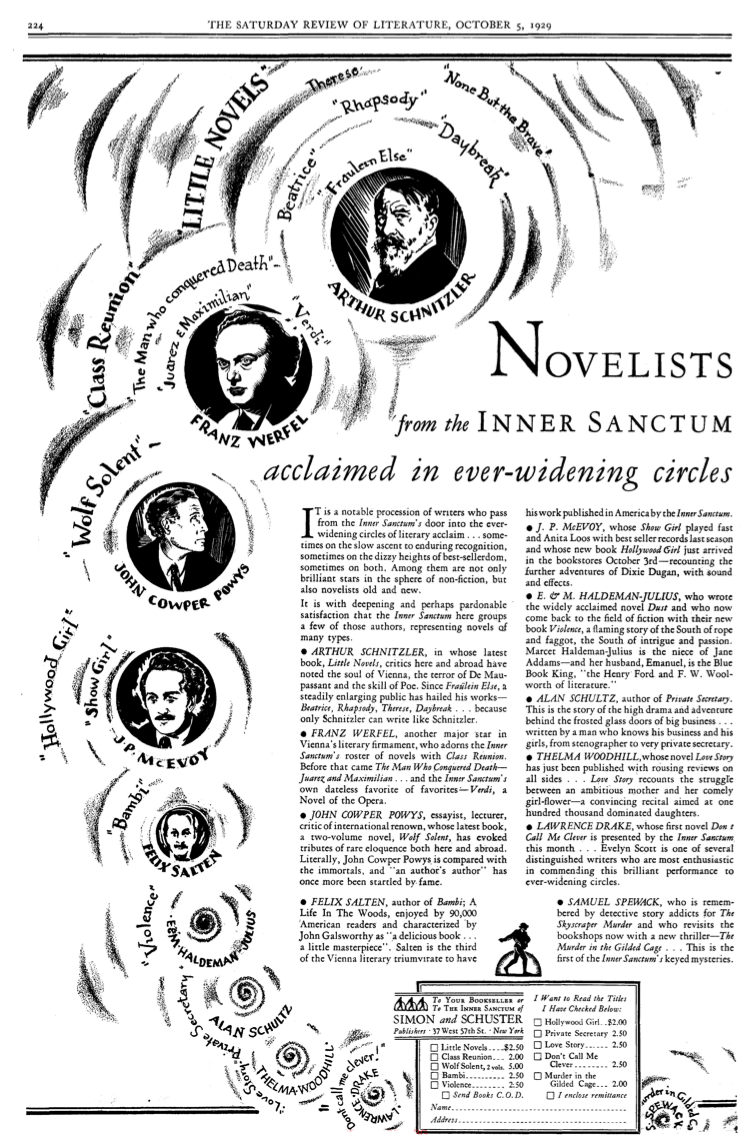 |
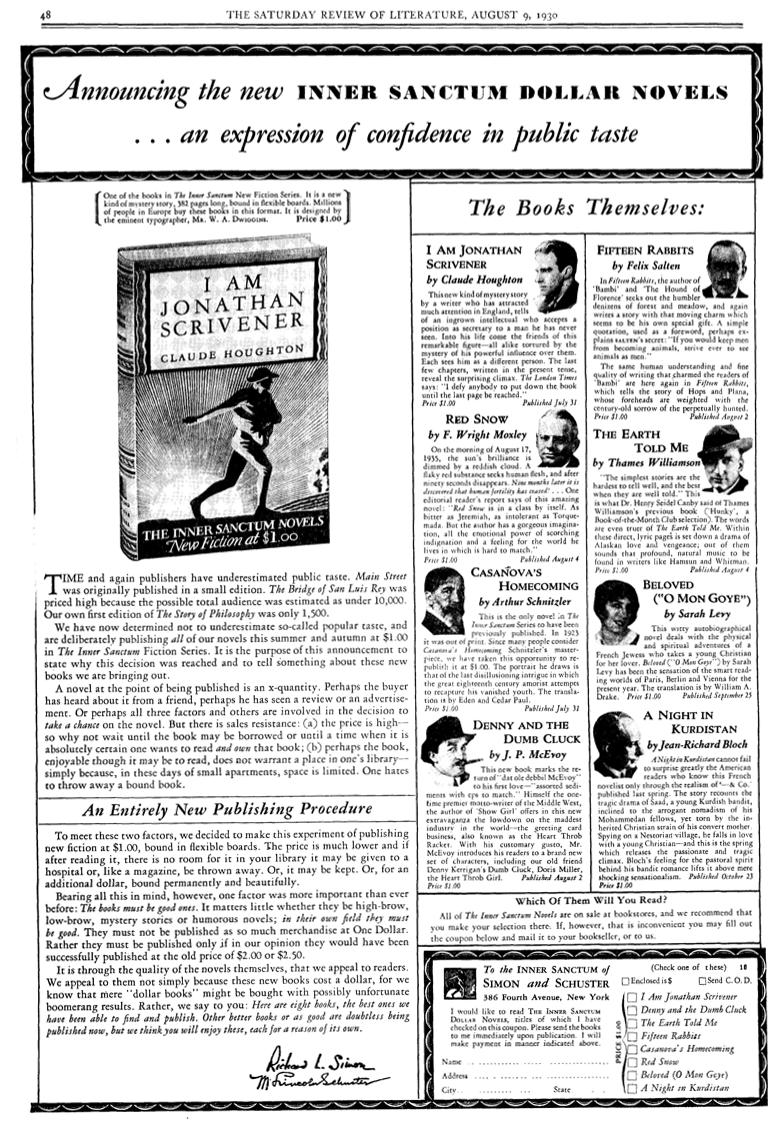 |
The Inner Sanctum Novels were designed by W.A. Dwiggins who himself had ideas about books and book design in the 1920s: “My formula was: Produce the ephemeral book on the basis of its real status. Do not try to conceal the cheapness as a part of the consistent design of the book.” (source) In other words, design a cheap book that wasn’t trying to look like a much more expensive book in form (using cheap materials), but was appealing.
Dwiggins design for the Inner Sanctum novels was likely influenced by his thoughts on a distinctive design for a cheap book series. The books did not have jackets, but in essence what could have been the jacket was glued to paper boards. This saved the cost of printing paper covers (and this kind minuscule cut in costs was relevant with these books).
The size of the book was larger than series like the Modern Library, adding heft and substance. Yet they were not the same (larger) size as typical (8vo) hardcovers. A distinctive cover design (common to the series with at least one exception) generated an aesthetic for the series, which suggests serious and substantive but approachable new literature.
The book below is The Earth Told Me by Thames Williamson. Williamson was from Idaho and had a colorful life. He published a half dozen novels, screenplays, texts on economics and children’s literature (under the pseudonym Waldo Fleming). (source)
The book covers consist of a redesigned version of the Simon & Schuster “Sower” (inspired by the 1850 Jean-François Millet painting of the same name). The title and author fill a rectangle at the top, and the series name (and price) at the bottom. The spine contains the title, author and publisher but no mention of the series name. The rear cover blurbs the book and lists the eight titles in the series:
Casanova’s Homecoming by Arthurs Schnitzler
Fifteen Rabbits by Felix Salten
Red Snow by F. Wright Moxley
The Earth Told Me by Thames Wlliamson
A Night In Kurdistan by Jean-Richard Bloch
Beloved: O Mon Goye by Sarah Levy
Denny an the Dumb Cluck by J.P. McEvoy
I Am Jonathan Scrivener by Claude Houghton
Jacket colors vary based on a tripartite division of titles:
1. Blue: Books in a more or less serious vein
2. Red: Books of a lighter nature
3. Green: Detective and mystery stories
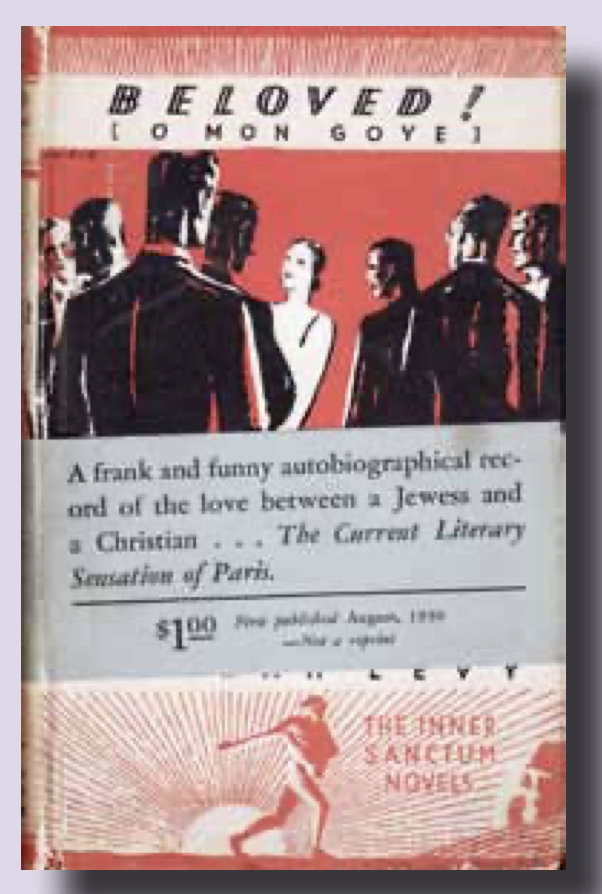 At least one title (Beloved, by Sarah Levy) included a wrap around band and variant jacket design (book not in my collection).
At least one title (Beloved, by Sarah Levy) included a wrap around band and variant jacket design (book not in my collection).
The printed book cover is affixed to heavy blue card stock which also serves as endpapers:
Instead of a half-title page, the books have a two page (!) explanation of the series and its aims. The text is interesting as insight into the thought that went into the series but it also seems a bit excessive and dramatic. I’ve reproduced the text below.
TO THE BUYER OF THIS BOOK
THE INNER SANCTUM NOVELS are an experiment in book publishing. It is the thought of the publishers that the buying of new fiction has been seriously handicapped in recent years by two chief causes:
1. THE PRICE. Whereas many non-fiction books are bought not only to read but to reread and refer to, most fiction is bought for one reading only. The price of fiction has remained relatively high because it has not been bought in quantities sufficient to enable a publisher to make use of the savings concomitant with large production. Meanwhile, unless the reader were certain he wanted to retain a book in his library, he has been content to borrow the book from a library or from a friend, (whenever that occasion might arise) or else he has decided not to read the book at all.
2. LIBRARY SPACE. This has in recent years become a serious problem. More and more people live in relatively small apartments in which the area of library shelves is limited. Where to put the books once they are read has become a real question.
The book has been bought, but who wants to throw away a bound book?
To meet these two factors, the publishers of this series of books have brought the price of all fiction (with the exception of extremely long novels) down to a dollar. You have now bought this book. If you do not wish to keep it, lend it to a friend, or send it to a hospital. Or, if you are clearing your shelves, throw it out with magazines. If, on the other hand, this is a book that you wish to keep bound in permanent form, take it to any bookbinder or send it back to the publishers with a remittance of one dollar, and it will be bound in cloth and returned to you postpaid.
Please note that the covers of THE INNER SANCTUM NOVELS have three separate colors: Red, Blue and Green.
1. BLUE. These are books in a more or less serious vein
2. RED. These are books of a lighter nature.
3. GREEN. These are Detective and Mystery stories.
This is a first edition copy. While THE INNER SANCTUM NOVELS are in their experimental stage the publishers would appreciate hearing comments on and criticisms of the new venture.
On the back cover of this book is a list of titles already in the series.
SIMON AND SCHUSTER, INC.
PUBLISHERS
386 FOURTH AVENUE
NEW YORK
The text indicates that for $1 the publisher would bind the book in cloth and return it post-paid. This was a feature of the paperbound Boni Paper Books series. I have no evidence (unlike with the Paper Books) that anyone took up Simon & Schuster up on this offer.
The title page is faced by a list of previous titles by the author. The title page includes the series name (as a colophon) and year of publication.
The copyright page indicates:
ALL RIGHTS RESERVED
COPYRIGHT, 1930, BY THAMES WILLIAMSON
PUBLISHED BY SIMON AND SCHUSTER, INC.
386 FOURTH AVE., NEW YORK
PRINTED IN U.S.A. BY
HADDON CRAFTSMEN, INC., CAMDEN, N.J.
BOUND BY H. WOLFF, EST., NEW YORK
DESIGNED BY W. A. DWIGGINS




